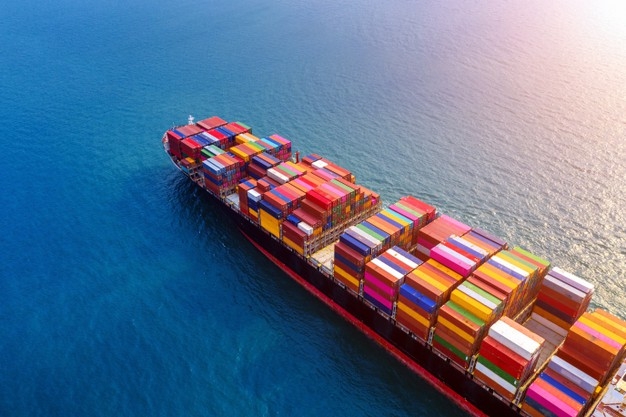Freight costs weigh down on disrupted businesses
 |
| Freight costs weigh down on disrupted businesses. Source: freepik.com |
Phan Van Viet, chairman of jeans and khaki producer Viet Thang Jean Co., Ltd. (VitaJean), said that the costs to ship goods in a shipping container have tripled during the global health crisis. The rate for a container from Vietnam to Europe has risen from $3,000 pre-pandemic to $10,000 last month, the highest on record. This has caused several obstacles for VitaJean’s export activities to overseas markets.
Viet further noted that despite rising shipping-container rates, the company could not increase selling prices with the contracts already signed before. High ocean-freight rates discourage customers to place new orders while some make slower payments than usual. As the situation continues to deteriorate, it is likely to weigh on the firm’s profit margin this year.
Meanwhile, Nguyen Dinh Tung, general director of fruit exporter Vina T&T Group, told VIR, “We have dealt with the challenges caused by rising ocean freight rates since July last year. This year, the company has to pay $6,000 per container to export its goods from Vietnam to the United States, which is three times higher than the rate of $1,800-2,000 last year. Headwinds in ocean freight result in several challenges including rising expenses and higher prices, which in turn lowers the competitiveness of made-in-Vietnam products.”
Although international carriers raise the freight rates, there is still strong demand in the market. Many companies accept higher fees to export their products from Vietnam to the US and Europe. While this trend hurts exporters and importers, ocean carriers are enjoying growing profits.
“While companies are struggling with the difficulties from another major outbreak in Vietnam, the rise of seaborne-freight costs sees no sign of cooling down. Thus, I hope that the government can work with foreign ocean carriers to address this problem soon,” Tung added.
According to the Vietnam Logistics Association (VLA), the spike in ocean freight rates comes from the fluctuating supply and demand in the market. US and European importers are ramping up the restocking of goods to serve the surging consumption demand. Meanwhile, the pandemic has disrupted the trade flow and affected the turnaround time of container vessels, which results in a shortage of empty containers. Thus, freight costs are projected to wind down when the demand for imports go down.
According to data from container liner Maersk, due to the pandemic there was a precipitous drop in the demand for container services in the second quarter of 2020. The demand plunged from 2.2 per cent in the preceding quarter to minus 8.3 per cent.
Starting from the second half of 2020, the restocking in the US and Europe has been raising demand whilst global measures to contain the pandemic have been causing severe strains across the supply chain, from a lack of vessels, containers, and trucks to significantly reduced productivity across ports, warehouses, and inland terminals.
And on top of these bottlenecks in the global supply chain, issues like the Suez Canal blockage and Yantian Port closure continue to put pressure on supply chains. A spokesperson from Maersk explained that the current market situation is exceptional. The current supply/demand picture has caused freight rates to spike, also driven by increased network costs from less efficient vessel operations, steep increases in charter rates, and box prices as well as alternative solutions to support customer supply chains.
“Equipment supply and the repositioning of empty containers remains a concern, but to further lessen the impact on our customers’ supply chains, given the extraordinary market conditions triggered by the global pandemic, we are accelerating the injection of new dry containers into our fleet,” she added. “By the end of the second quarter, we will have added around 260,000 twenty-foot equivalent units (TEU). This comes after the 400,000 TEUs already added to our fleet from July 2020 to January. We also have deployed all available vessels in our fleet and chartered in all available capacity.”
The Drewry World Container Index released on May 27 showed the rate for a 40-foot container from Asia to the Europe shot above $10,000 for the first time on record. Industry insiders predict that the trend of high freight costs will continue to the third quarter of 2021, impacting exporters’ business results.
What the stars mean:
★ Poor ★ ★ Promising ★★★ Good ★★★★ Very good ★★★★★ Exceptional
Related Contents
Latest News
More News
- Ho Chi Minh City hits $8.37 billion in FDI (December 29, 2025 | 08:28)
- Tax sector wraps up 2025 and sets priorities for next year (December 25, 2025 | 14:00)
- Heavy industries set for pilot greenhouse gas quotas (December 25, 2025 | 10:00)
- $250 million deal targets women-owned SMEs, sustainable agriculture (December 22, 2025 | 17:40)
- UOB sees Vietnam growth easing in fourth quarter (December 22, 2025 | 17:39)
- Government moves to establish International Financial Centre (December 21, 2025 | 21:00)
- Vietnam's IFC to target global investment flows (December 21, 2025 | 18:00)
- Ha Tinh breaks ground on major Vingroup industrial and energy projects (December 19, 2025 | 18:24)
- EVN launches major power infrastructure projects nationwide (December 19, 2025 | 18:17)
- VAL inaugurates second production line to meet domestic animal feed demand (December 19, 2025 | 16:37)

 Tag:
Tag:

















 Mobile Version
Mobile Version